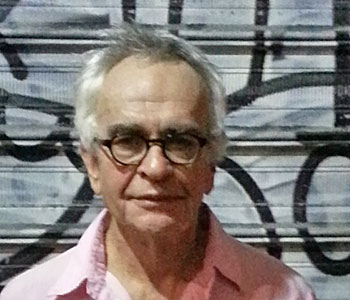Wendy Z. Goldman
Inventing the Enemy: Denunciation and Terror in Stalin’s Russia
Cambridge University Press
336 pages, 6 x 9 inches
ISBN 978 0521191968 hb
ISBN 978 0521145626 pb
Inventing the Enemy is about the period known as the “Great Terror” in the Soviet Union. At the height of the terror in 1937–38, the Soviet secret police under the People’s Commissariat of Internal Affairs (NKVD), arrested approximately 1.6 million people for political crimes. More than 1.3 million were convicted, and about 683,000 executed.
The book, however, does not focus only on numbers. I use a unique body of sources to reconstruct how ordinary people reacted to the terror and how they were affected by it.
Inventing the Enemy is structured around human relationships in five Moscow factories. The first chapter provides a political background to the terror, explaining the events that set it in motion and the poisonous climate of fear and denunciation that soon enveloped the country. The next three chapters, the heart of the book, are built around ties among people at work and at home. Separate chapters focus on relations among coworkers, family, friends, and lovers. The final chapter describes how the terror came to an end as the most ardent proponents of terror were arrested and sent to the camps as “bawlers,” or denouncers of the innocent. An epilogue, “A History without Heroes,” analyzes the range of human behavior possible during the terror, and shows how ordinary citizens collaborated, participated in, and resisted the denunciations, mass meetings, and arrests of the time.
The book is based on a unique body of sources: stenographic reports of meetings of local communist party committees in Moscow’s factories. I never could have done this research without access to previously secret archival materials contained in the Central Archive of Social- Political History of Moscow (TsAOPIM).
I paired the reports, which were verbatim transcripts of what people said at meetings at the time, with daily factory newspapers. These two sources together allowed me to reconstruct almost a day-by-day account of what occurred during the terror.
This is not a history of famous party leaders or celebrated intellectuals. It is about the recovered experiences, behavior, and responses of ordinary people and their families.
When I first looked at the stenographic reports of the meetings I was amazed. It was quite literally as if I had been transported back to a factory in the Soviet Union at the height of the terror, and I was sitting in a meeting surrounded by workers, foremen, managers, and other members of the Communist Party.
As I read through the stenographic reports over months and years, I felt as if I was getting to know people personally through their behavior at the meetings. I learned their names, jobs, and followed their behavior over time. Gradually, I was able to piece together their relationships to one another, their family backgrounds, and their personal secrets.
I listened to how people responded to attacks, how they attacked others, and how they participated in the political events that gradually engulfed them. It was possible both to read people’s behavior as it unfolded at the time as well as with hindsight. With patient, painstaking reconstruction, I was able to reread certain actions with my subsequent knowledge of what was to come. For example, in several cases I learned later that ardent denouncers of others were concealing their own secrets regarding the arrest of family members. Interestingly, a person’s own private experiences with victimization often made them more rabid in their public denunciations of others.
Inventing the Enemy grew out of my previous book, Terror and Democracy in the Age of Stalin, which described the impact of the terror on the unions, workers, and industry. I used some of the stenographic reports in Terror and Democracy, but I was never able to explore the deeper psychological dimensions of people’s experiences. In this sense, Inventing the Enemy grew directly out of my desire to analyze these sources more fully in terms of what they told us about personal and collective behavior.
The book makes several controversial arguments.
The first is that ordinary Soviet citizens participated widely and actively in the terror.
This argument is at odds with the popular view that the terror was solely a top down phenomenon directed by Stalin and motivated by his drive for absolute power. My research at the local level shows that ordinary people also participated in the terror by writing secret denunciations to the NKVD, by speaking against coworkers at meetings, by naming names, and by preemptive attacks on others to demonstrate their own loyalty. These behaviors were motivated by genuine belief in alleged enemies, by fear of exposure or attack, and in many cases by both. Faith in and fear of the state operated at the same time, and often, were intertwined in the responses of the same person. Many of the strategies that people used to protect themselves increased the risk to others and helped to spread the terror.
The second argument of the book is that the line between victims and perpetrators was very blurred. Unlike memoirs of the terror, which are based on individual recollections and stress the innocence of the victim, the stenographic reports show people acting in real time. We see people denouncing others, and then becoming victims themselves of the very political culture they initially helped to create and sustain.
This argument, too, is at odds with the dominant view of the terror, which tends to cast Soviet society as the innocent victim of an evil Stalin. The book explodes this simplistic analysis to reveal far more complex behaviors. In one case, I discovered that a factory manager had written several secret denunciations of his coworkers to the Party and the NKVD. At the same time, his own relatives had been arrested and he was sending food and money to them in the camps. Of course, it was a grave violation of Party rules to render aid to people who had been deemed enemies. His double actions, denouncing so called enemies while sending aid to others, made me think more carefully about belief and behavior in that time.
The third argument of the book is that Soviet society was crisscrossed by a web of familial, work, and friendship ties that drew everyone into the vortex of the terror.
Historians have previously considered various victim groups separate from one another. I argue, however, that the family connected former oppositionists, kulaks, recidivist criminals, Latvians, Poles, and other victim groups to workers and communist party members, key supporters of the state.
Once I shifted my lens of inquiry from state orders to the family, I realized that many loyal rank and file Communists and workers had relatives who fell into suspect categories. In fact, everyone was vulnerable to victimization through associational ties. According to party rules, party members had to report the arrests of relatives, friends, bosses or employees to their party cells. Party members agonized about whether to declare these arrests or to conceal them.
The Communist Party was not a group walled off from the rest of the population, but in fact, its members often had family ties to various groups targeted by the state. Any one family might have a working-class communist father, a former oppositionist uncle, a Polish brother-in-law, or a dispossessed kulak grandfather.
The chapter, “Love, Loyalty and Betrayal,” centers on Aleksandr Somov, the head of the Hammer and Sickle factory’s party committee, who possessed an impeccable proletarian biography. Yet Somov was thrown out of the Party as a result of his close relationship with a young Polish communist woman who was arrested in the national operations. The chapter shows that not even the most “perfect biography” could provide immunity to arrest.
It is thus impossible to regard the terror solely as a set of targeted actions by Stalin and the state against specific victim groups. Everyone in those dark times was victimized to one degree or another, and everyone participated in victimization. No social or political group was left untouched.
The front cover of the book reproduces a very powerful painting and is worth looking at carefully. Dmitri Zhilinskii, the artist, painted it from memory. It depicts his own father’s arrest in 1937. Zhilinskii includes himself as a young child (on the spine of the book), standing in his underwear and watching the NKVD’s midnight search of his family’s small apartment. His father stands in the center of the painting with his hands raised in surrender. The title of the painting is “1937,” a year that is a synonym for the terror. The painting now hangs in the Tretiakov Museum in Moscow.
Readers will find many gripping stories about personal relationships, dark secrets, and twisted behavior in these pages.
None of the betrayals depicted here are foreign to us as human beings. I think my readers will be able to project themselves into every agonizing dilemma faced by Soviet citizens.
I would suggest that a browser open the book to page 140, the first page of the chapter “Family Secrets.” Here, on this page, the reader will meet Margolina, a party member who worked in a textile factory. Margolina comes home from work one day to find a mysterious postcard in her mailbox, sent by her brother in Kharkov. The postcard contains a single, cryptic line. It states that Margolina’s married stepsister “was alone.” Margolina immediately grasps the terrifying meaning of the message, as well as its ability to upend her own life.
This book is particularly relevant for anyone today who is concerned about how our own “war on terror” is affecting civil liberties.
Inventing the Enemy shows that the terror in Soviet Union actually began as a series of “anti-terrorist” measures in the wake of the assassination of a popular Soviet leader, Sergei M. Kirov. These measures introduced extra judicial trials and eliminated the right to appeal for suspected terrorists. As more suspects were pulled into prison and subjected to brutal methods of interrogation, Soviet leaders became convinced of a vast conspiracy of terrorists, potential and real.
The climate of fear spurred by the Kirov assassination was intensified by the growing threat of fascism abroad. Soviet leaders encouraged ordinary citizens to denounce those they suspected of disloyalty or treason. Many Soviet citizens denounced their neighbors, coworkers, and even family members.
My argument—and a lesson—is that ordinary citizens helped to create a political culture that supported the abrogation of civil liberties.
Yet as more and more people were arrested, many others realized that they, too, might become victims. What began as anti-terror measures in the wake of a political assassination became a true terror.
Inventing the Enemy shows us how an anti terrorist campaign launched by the state can become a full blown terror in which one’s fellow citizens become rabid agents of denunciation and no one is safe.




We don't put paywalls. We don't distract you with ads. We don't sell your data.
Please help to keep this running!